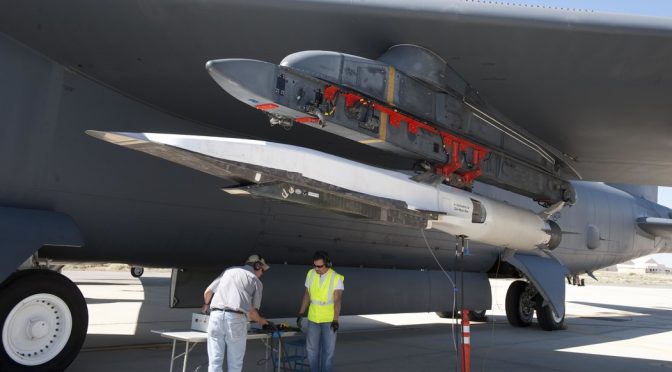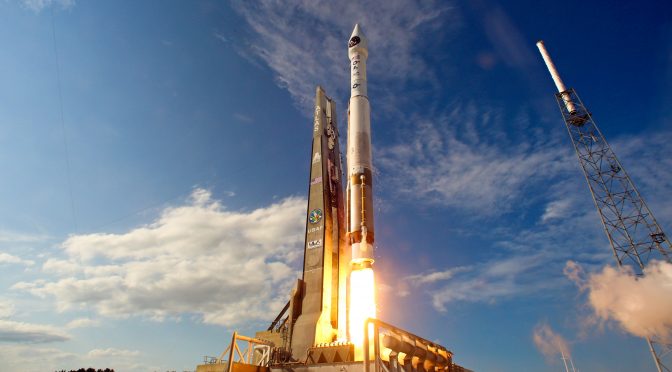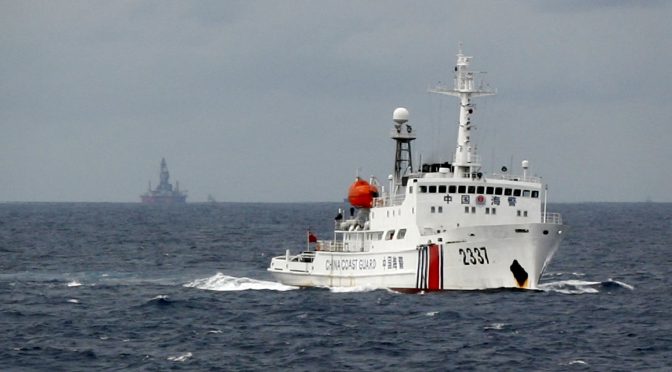By Jon Isaac
Introduction
In January 2019, Chinese Communist Party leaders announced that the newest iteration of their DF-17 missile system was being designed to overwhelm and sink U.S. aircraft carriers and surface combatants stationed in the West Pacific. According to official statements from the People’s Liberation Army Rocket Force (PLARF), a targeted salvo of eight hypersonic glide vehicles (HGVs) set aloft by DF-17s would swamp a surface vessel’s close-in point defenses and annihilate it through incredible transfers of kinetic energy. This type of inflammatory language is not new and Chinese officials have been known to exaggerate the capabilities of their military. However, discussion of the DF-17 and similar weapon systems as conventional, theater-level assets, rather than the strategic nuclear capabilities generally associated with hypersonic missiles, poses a set of very serious and immediate threats to decision-makers in Washington.
Rather than continue the popular trend of treating hypersonic weapons primarily as delivery mechanisms for nuclear warheads aimed at strategic targets, China has been quick to utilize the technology to augment its theater-level Anti-Access/Area Denial (A2AD) capabilities. Such developments suggest that the most critical threat posed by hypersonic weapons is not strategic, but tactical, operational, and conventional. A focus on hypersonic weapons as operational threats is not a novel concept, though it merits further review as near-peer adversaries continue to develop hypersonic capabilities. Michael Griffin, Under Secretary of Defense for Research and Engineering, argued recently that the “tactical capability that these sorts of weapons bring to theater conflicts or regional conflicts” is at the core of the hypersonic threat.
Most service branches seem to have adopted a view similar to Griffin’s, with the Army, Air Force, and Navy all independently developing hypersonic platforms intended for a myriad of tactical and operational purposes. For the Navy, however, hypersonics could represent a tectonic shift in weapons technology on par with the decline of battleships and the rise of the aircraft carrier during the Second World War. Indeed, Russia and China’s development and deployment of hypersonic weapons could challenge the decades-long assumption that U.S. naval assets can operate with complete freedom of movement and comparatively little legitimate threat to their survivability. While anti-ship cruise missiles or attack aircraft can be countered through point defense batteries, electronic countermeasures, or even directed energy systems, conventionally armed hypersonic weapons could likely render existing defenses ineffective. As such, with the focus on conventional hypersonics on the rise, the operational impacts of hypersonic weapons systems on the US Navy merit analysis and could prompt a series of doctrinal shifts which could then enhance surface survivability in the hypersonic era. Before engaging in any such analysis, however, one must first grapple with the concept of hypersonics as a whole.
What is a Hypersonic Weapon?
Hypersonic missiles and glide projectiles are those which travel at least Mach 5, or five times faster than the speed of sound. In round numbers, this equates to a speed of about a mile a second. For comparison, even the quickest modern fighters generally top out around Mach 2, with only specialized aircraft capable of reaching Mach 3. Once an airframe reaches Mach 4, 5, and beyond, specialized technologies like supersonic combustion ramjets, or SCRAMJETs, must be used to carve through the air. Unlike traditional jet engines, SCRAMJETs use no moving parts or machinery to direct and combust air, thereby making them incredibly efficient at plowing an airframe through the sky at incredibly high speeds.
Though manned hypersonic flight has occurred in the past, most notably with USAF Major Robert White’s 1961 flight in the NASA X-15, today the technology is most promising when used to propel unmanned vehicles and missiles. Presently, most high-profile hypersonic weapons utilize either SCRAMJET propulsion, as is the case with hypersonic cruise missiles, or are unpowered glide vehicles which are propelled to extreme altitudes by ballistic missile systems, only to turn back towards the surface and glide at extreme speeds towards their targets on a non-ballistic trajectory. This distinction is important, as both hypersonic cruise missiles (HCM) and hypersonic glide vehicles (HGV) are being touted as globally destabilizing weapons systems.
Put simply, hypersonic missiles are dangerously fast. So fast, in fact, that they are relatively impervious to currently fielded missile defense technology. Theater level missile defense systems like Terminal High Altitude Area Defense (THAAD) batteries and the Patriot point-defense missile systems are designed to counter ballistic weapons which fly on relatively predictable speeds and flight trajectories. Conversely, hypersonic cruise missiles and glide vehicles can move erratically and at such incredible speeds so as to render existing defenses mostly irrelevant.
The value of such capability has not gone unnoticed by adversaries. Russia, for example, successfully tested a hypersonic glide vehicle known as Avangard just this past December. The weapon, they claim, is capable of reaching terminal glide speeds of almost 27 times the speed of sound. The validity of that speed claim has been disputed by a number of experts and defense media outlets, but one thing is known for sure – the weapon exists and the weapon works. Meanwhile, China spent most of 2018 conducting more hypersonic weapons tests than the United States has conducted in the past decade. America’s adversaries have funneled enough resources and manpower into developing hypersonic weapons to raise some eyebrows in Washington, not the least of which include the United States Navy.
What Does This Mean for the Navy?
Since the end of the Second World War, the U.S. Navy has been able to operate with relative impunity throughout the world’s oceans. At the center of American postwar maritime dominance is the aircraft carrier. While hulking battleships of old held the status of capital ships in U.S. fleets, aircraft carriers rose to prominence as the crown jewel of American power projection. As a result, aircraft carrier battle groups have stood at the cornerstone of American power projection strategy in the late 20th and early 21st centuries and have been able to impose their will (and firepower) upon almost any target on the globe. Much in line with the Mahanian fleet doctrines which helped to drive America to victory in the Pacific, modern surface warfare strategies have seen the Navy organize its fleets and surface action groups around a prime directive, protect the aircraft carrier. To date, this strategy has proven successful (albeit with no serious tests in actual combat), with submarine screens, active electronic warfare measures, air defense umbrellas, and AEGIS-equipped surface assets acting as an impenetrable wall behind which America’s flattops are safe from any potential foe.
What happens, then, when new technologies render virtually all existing missile defense and point defense assets ineffective? What happens when the very foundation of modern American maritime dominance, the aircraft carrier battle group, is held at risk by missiles and high-trajectory, high-speed kinetic glide vehicles which are, as admitted by the Pentagon, extremely challenging to existing missile defenses?
This is the fundamental problem with which the Navy must now address. It must be noted, however, that this type of threat against the carrier battle group is not entirely new to the surface warfare community. For example, China’s decades-long development efforts and eventual deployment of Anti-Ship Cruise Missiles (ASCM) and Anti-Ship Ballistic Missiles (ASBM) as core to its A2/AD network brought into question the viability of the carrier battle group and questioned whether the hulking warships had a future in a modern battlespace. For the past decade, analysts debated the ramifications of Chinese anti-ship missile capabilities, with increased debate on the topic springing about within the Obama-era Air-Sea Battle concept. A primary feature of the Chinese threat is the reality that increased ASCM and ASBM capabilities may force American carrier battlegroups further out to sea to avoid closing range between themselves and anti-ship missile batteries on shore. In response, analysts have prescribed everything from increased escort vessels to the newly-awarded MQ-25 Stingray Carrier-Based Aerial-Refueling System (CBARS) as ways to increase carrier survivability. These prescriptions have offered a diverse set of solutions, with the former hoping to deny ASCM/ASMB strikes through conventional air defense and the latter ensuring carrier battle group effectiveness by increasing the reach of conventional strike fighters. In short, threats to the carrier battle group are not new. What makes hypersonics different?
Unlike conventional ASCMs, ASBMs, and other A2/AD threats, there is currently no technological counter to the hypersonic threat. Existing joint efforts between the service branches and DARPA, like the recently announced Glide Breaker program, have endeavored to come up with a viable defense to stop hypersonic weapons from bypassing existing missile defense networks. Unfortunately, no immediately viable kinetic counter-hypersonic technologies have been identified or developed. To make matters worse, top defense officials in the Pentagon’s technology development offices have diagnosed that even existing radar systems would be unable to adequately track and identify a hypersonic threat, to say nothing of prosecuting or defeating such a threat.
The news is not all bad, however. For example, space based sensor arrays have been touted by DOD officials as viable means for “warning, launch detection, surveillance, acquisition, [and] tracking” of hypersonic threats. Similarly, despite the technological challenges, offices like the DOD’s Missile Defense Agency and DARPA have charged ahead at examining high-saturation kinetic projectiles and even directed energy weapons as potential means for destroying hypersonics on a strategic level. While these efforts are all well and good, however, their technological immaturity and prohibitive cost betray the lack of capability to protect American naval assets from hypersonics in the next few years.
Clearly, then, to address the hypersonic threat in the immediate short-term, the Navy cannot rely on technological development and the traditional edge offered by American technological dominance. Instead of looking to laboratories and development houses for hardware tools to counter the threat of hypersonic weapons, the Navy must look to its own assets and shift traditional surface warfare doctrines to ensure survivability. Three doctrinal shifts stand out as potential options for responding to the theater-based use of conventional hypersonics, each with varying levels of plausibility and effectiveness.
Potential Fleet Options
First, a decreased reliance on the concentrated “porcupine” structure of a carrier battle group in favor of distributed use of destroyers, cruisers, smaller LHD flattops, and even LPD transport docks could provide adversaries with such a widely spread set of targets so as to make concentrated hypersonic attack, like the “eight salvo” mission as described by Chinese authorities, unfeasible. By disaggregating targets around carrier battle groups, the Navy could deny its adversaries the ability to reach the concentration levels of hypersonic firepower needed to effectively eliminate the target. This shift is not without its faults. The notion of networked and distributed surface operations is not a new one and blunders in attempting to implement this type of fleet structure in the past have been the bane of the surface Navy. Moreover, the act of distributing and decreasing the density of American warships in a surface action group or carrier battle group could limit the power projection capabilities of such a force, thereby hindering one of the Navy’s core missions.
A second option posits that further utilization of unmanned undersea assets and existing nuclear-powered submarines may prove to be an effective way to address some of the shortcomings brought about by a more vulnerable carrier battle group. For example, increased development and deployment of guided missile submarines, be they conventional boats like the Navy’s modified Ohio-class SSGNs or emerging unmanned options like Boeing’s Orca/Echo Voyager XLUUV platform, would provide the Navy with several far-forward domain capabilities. Such assets would allow the Navy to field missile strike and reconnaissance assets closer to adversary coastlines without bringing surface assets into the effective reach of hypersonic weapons. While submarines will never be able to field their own independent combat air wing or project visible American power in the same way a carrier can, they could engage in some of the maritime patrol and missile strike projection operations previously led by carrier battle groups. Again, this is not an impervious solution since many of the key operations shouldered by aircraft carriers are unique to their incredible deterrence and firepower projection capabilities.
Finally, DARPA and the Department of the Navy have highlighted increased conventional missile deterrence and conventional disruption operations as potential routes for driving adversaries to “think twice” in the use of their hypersonic missiles in the first place. As argued by Robert Farley, a professor at the Army War College in Carlisle, PA, there are an incredibly complex series of decisions and steps which must go off without a hitch for an adversary to successfully conduct a strike against a carrier battle group. “Disrupting any single one,” Farley writes, “can slow or entirely avoid the attack.” As such, the Navy could structure its fleet doctrines and operational focuses to counter the myriad of technologies which support a hypersonic strike, rather than attempt to counter the hypersonic weapon itself. For example, targeted jamming of missile guidance nodes around the region or destruction of the aircraft and satellites which are required to guide such a weapon to its target. This notion spreads beyond merely Navy-commanded operations, with cyber-attacks on networked hypersonic systems standing as a possible counter to their launch and targeting.
Like with previous suggestions, this “full spectrum” approach to preventing hypersonic targeting or strike of a traditional surface group is not without its flaws. For example, preemptively engaging in any such attacks or jamming operations could escalate a tactical or immediate political situation. Though it could decrease the likelihood of a successful hypersonic strike, thereby freeing up American carrier battle groups to do what they do best, it could just as easily prove pyrrhic should the situation escalate out of control.
Still, there is no single doctrinal answer to the hypersonic threat. Instead, the Navy must be willing to evolve from the sacred and historically effective Mahanian capital-ship doctrine which it has adhered to in the past and adopt surface organization tactics which decrease the likelihood of a hypersonic attack in the first place and minimize the potential effectiveness of such an attack should it take place.
Conclusion
For the past few months, press sources have been flooding the internet with stories about impervious hypersonic weapons which could deliver nuclear warheads onto targets in the American homeland quickly and with no warning. While the hypersonic nuclear threat is a valid one, focusing on it betrays the real threat posed by conventional hypersonic systems which are not subject to the deterrent effects of the American nuclear triad. Conventional operational use of hypersonic weapons could render existing naval surface asset structures ineffective. Rather than rely on the historically dominant American tech sector, however, the Navy must address the short-term threats posed by hypersonics through evolution of warfighting doctrine, tactics, and fleet organization. Just as aviation development brought a close to the age of the battleship, hypersonic weapons could bring to end the age of the traditional carrier battle group.
Jon Isaac is a pseudonym for a developing security analyst.
Featured Image: Ground crew members make the final checks to the X-51A Waverider scramjet, which is affixed to an Edwards B-52H Stratofortress before being flown over the Pacific Ocean and launched June 13, 2011. (Photo by Bob Ferguson/Boeing)





